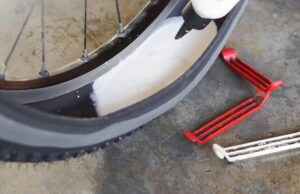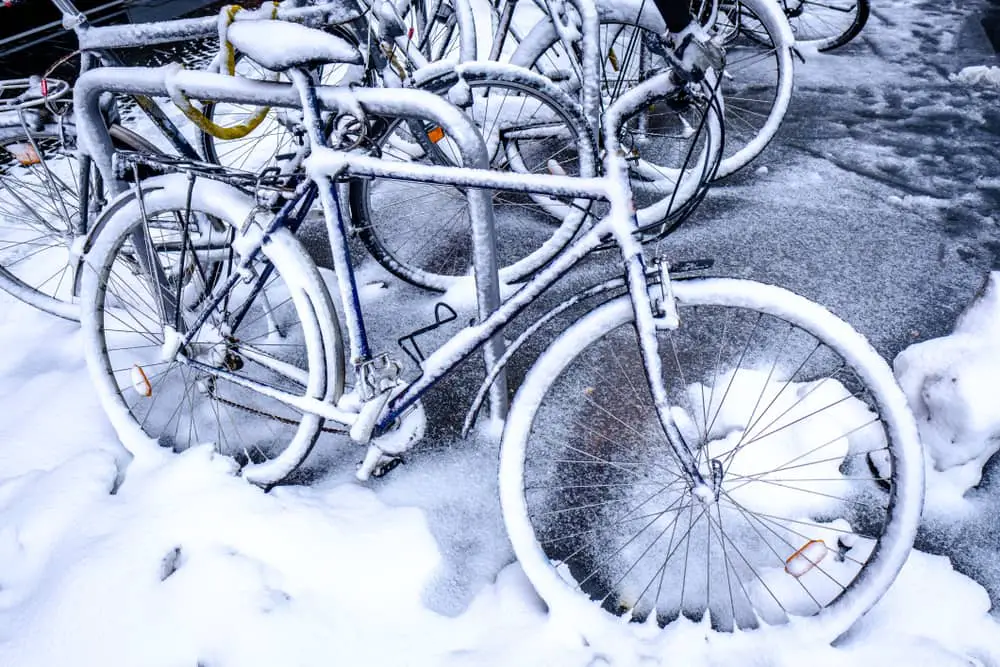When riding a bike daily, the tire pressure stays constant and doesn’t need to inflate. Unfortunately, leaving without using the bike makes the tire flat and demand inflating. But why do bike tires go flat when not in use?
Generally, the tire becomes flat when you leave the bike for a few days or sometimes overnight due to the cold environment. When the heat is gone, things like tires gradually deflate, the tire might become punctured, or issues like dry rot, valve problems, tire puncturing, or possibly the old aged weak tire missing out holding air inside the tire.
Fortunately, fixing the unused flat tire can be resolved by following some easy tips we would like to present in this article. So, say goodbye to the flat tire. Now, let’s look at the many facts on unused flat bike tires.
Do Tires Randomly Go Flat?
Yes, the bike tire may get flat since we never detect the tire’s condition. Usually, the tires are relatively porous and do not seal completely, so the air leakage is natural.
When you drive, the tire condition weakens, and the tread decreases with distance. Even the tire becomes more sensitive over time and increases the possibility of an accident while driving. On the other hand, if it’s a cold environment, your tire normally loses the tire’s air pressure.
Do Bike Tires Go Flat From Sitting?
Indeed, even after having no damage in the tube or tire, bicycle tires can become flat over time. We have found many reasons behind the bike tire problem where the tire becomes empty without air.
Naturally, despite being 99% airtight, your tires may still lose little air each day. Yet, among all the issues, the major problems are air leakage by punctures, broken or corroded wheels, cold weather, humidity, direct sunlight, and some other facts.
Can a Bike Tire Go Flat Without a Hole?
Suppose the query is, “why does my rear bike tire keep going flat?” If you can’t find the hole causing a flat tire, do you need to replace the tube?
When you miss putting enough air while inflating, the tire goes flat, and we detect valve damage. The tire will lose pressure gradually from air leaks, damage to the valve steams, abrasions, or rim strips to the tire. As a result, you should check the casing thoroughly by using your fingertips to feel it and inspect the possible issue.
How Fast the Unused Bicycle Tires Deflate?
Tire typically remains good for around three years. However, due to some circumstances, you will notice some facts such as:
- You can withstand five psi for around two days, but when it’s 60 psi, you can keep it for only a few hours.
- Any regular narrow road bike tire can be dropped by half within two days.
- Mountain bike tires inflated to 20 to 30 psi keep air longer and last for a week.
- But if it’s a hybrid bicycle tire inflated to 40 psi, it won’t reduce the air pressure within 1 or 2 months.
- The road bike tires need to be inflated daily throughout the summertime since the pressure drops from 110 to 90 psi quickly.
Where Does Air Exit My Tires From?
Bike air can escape from anywhere on your tire. But the most commonly noticeable locations are:
- The air will undoubtedly escape from your bicycle tire when it has a gradual leak or little puncture.
- Air can escape due to nails or other sharp objects in the road that make a hole in the tread.
- There might be a hole in the sidewall that happened to any outside pressure.
- A weak seal at the wheel’s tire attachment point allows the air to escape.
- Another issue is a weakening between the inside tube and the air valve.
Bear in mind that tires commonly lose one psi of air each month, and check them to keep the cleanliness of the bike tire. Also, the air can escape from the tube due to a few additional problems, which will be revealed in the upcoming section of this article.
Why Do Bike Tires Go Flat When Not in Use – 15 Possible Reasons
We already indicated that bike tires could become flat due to multiple causes. Whether naturally or due to the condition, today or tomorrow, your bike tires will let the air escape.
However, we have enlisted 20 major reasons behind the flat tire. After long research on the forum sites Quora and Reddit, we discovered most users have queries on such problems that we will discuss.
Puncture or Cuts in the Tire
A puncture or leak is the most frequent problem that allows a tire’s air to escape. Any sharp object can puncture the inner tire of your bicycle. Similarly, the thorn, debris, small rock snail, snakebite, or little pinprick caused by a glass fragment can cut or puncture the bike tire and make it flat.
Besides that, it could be a slow leak caused by a puncture, rim seal, sidewall, abrasion, or valve stem. So, it would be best to inspect the tire’s outside and inside with gloves because a sharp stuck object can cause damage to the tire. Or you can patch the tie or replace it after leaking as repairing won’t remain the same as the intact new tire.
Bike Valves That Are Damaged
Leakage can also come from the valve. The bicycle tire’s valve is likely damaged and loose. When you fail to close the cover tightly, the tire may lose all its air within a week.
Therefore, you can check the tire’s valve to ensure all bike parts, such as tubes, puncture-resistant inside cores, and rim wheels, are tightened properly.
Lack of Proper Installation
When you don’t install the tire with the bike, air from the tube can be lost. Additionally, the tube can become stuck between the tire bead and rim, eventually creating a bubble that explodes when the tire bead compresses.
Manufacturer’s Bike-Making Mistake
When the brands of bike tires are disreputable, the potential for new product item weakness is another nightmare. Also, the material flaw can cause a little rip even in your latest bike.
Tire Problem
You’ll notice the tire deflating or puncturing when the tire pressure rises or if there is a bulge, cracks, or other issues. Thus, it’s always a good idea to inspect the tires routinely.
Burping
It’s a side effect of changing the ignition system during any shifting for quick reduction in RPM and upshift. When burps, the other produces fluids high in CO2, and the bike tires lose air.
Pneumatic Bike Tire
We use the pneumatic tire to give the compressed air a flexible covering with an impermeable layer. However, you should use the pump and blow it up.
Tubeless Bike Tire

A tubeless tire that is losing air without puncture can be resolved by removing the outdated patches, and then adding some air or inflating the tube will fix it. After repairing the flat tire, no cuts are required.
The Porosity Of Rubber
The space in a rock is considered porosity. Bicycle tires are made of rubber which is naturally porous. They will eventually leak and puncture as the structure of the sponge or rubber has tiny holes and gaps throughout.
Millions of air molecules exist in the tube when you pump it so that inside tubes may maintain the pressure for a while. The molecules inside the tires eventually make their way out of these tiny holes and cause air loss, where many riders fill their tires with pressurized CO2 on the road.
Dry Rot
Leaving the tire for a long time lets the tires or tubes break and degrade, and the tires become dry rot. Basically, tires that experience serious environmental changes like extreme cold, high humidity, or direct sunlight will cause dry rot.
However, you can identify the problem by looking specifically near knobs and seams. In addition, cracks that are flaky or seem dry are a common indication of dry rot. As a result, the tire needs to be replaced immediately.
Cold Weather
Another factor that damages the bike tire when left unused is the cold or winter. Such conditions soften the tires more than in the summertime.
Air molecules move more slowly and condense when the temperature drops. The total reduction in molecular motion leads to a drop in air pressure. Therefore, the tire pressure should be under control.
Old Aged Tire
Flat tires can be seen overnight and over time by deteriorated, weakened, and deflated. So, it’s a good idea to use the same tire for an extended period once you maintain flexibility. Actually, any breakdown will cause a simple weakness to develop into a tiny rip that progressively leaks.
Avoid Over-inflated Wheels
Also, only put a little air on the wheels. The tire will get flattened due to excessive pressure. Hence the air should be expanded to the appropriate pressure.
Quality Of Tire
Tire and tube quality should be considered as it will keep the tire safe from becoming flat. Moreover, avoid exposing the bicycle tires or tubes to a bad environment, as excessively hot and cold can disturb the air pressure.
Remember, whether it’s an external or an internal tire, quality should be first-class, or you’ll find it flat shortly. Otherwise, the tire will tear or wear out quickly.
Rim Tape Torn Out
We discovered a biker has complained about the front tire issue where the tire got flat. The person found the rim tape had torn at the valve location, allowing the spoke to contact the tube and somehow puncture. The spoke holes pointed corners have damaged the bike’s tubing and made the tire empty.
Things to Consider When Bike Tire Loses Air
The new bike tire keeps going flat, and you can’t do anything! Isn’t this a sad condition? Yes, it is! So, if you find out the tire is dying and emptying the air, check some crucial things to resolve the issue.
Inspect the inside and outside of your bike tire, whether it’s a fat bike, road bike, or any mountain bike.
- Check for any holes that are allowing the air to escape.
- Inspect any damages, thorns, or stuck objects in the tube.
- It would help if you also searched for any cuts on the sidewalls.
- Look for any dirt and debris inside the tire.
- Remember to check the bicycle’s valve.
- Running over any stuff on the road might have leaked or punctured the tire, so fix it ASAP.
- Ensure you don’t have any wheel problems.
- Detect excessive pressure or too much low pressure.
- Check to see if the molecules have grown.
- Detect any hiss or click noise.
- Sealant level checking is crucial when you have tubeless tires.
- And make sure the tire has been inflated with the right level of air pressure.
How to Keep Bike Tires From Going Flat – 10 Easy Solutions
Proper maintenance and regular checking of the tires are the roots of all solutions! Besides that, we have some easy-fixing ideas for the biker.
- Using baby powder when attaching tubes or, in the case of tubeless tires, you should use soapy water, regular replacement, filling off the sealant, and cleaning the valve cores are crucial.
- The easiest way to fix a flat tire is to use a bike pump, inner tube patch kit, and tire lever.
- Always keep your bike somewhere dry and shaded, as direct sunlight is an enemy, and don’t expose the tires or bike tubes to harsh weather like excessively hot or cold.
- The proper positioning and installation of bike tires should also be prioritized, or you’ll find them flat.
- You should also check the damages or problems with the wheels’ spokes, axle, or bearings to understand if you need to replace or repair them.
- Put the tube over the wheel rim, then ensure that you don’t see any bubbles coming out from the inside of the tube.
- Ensure you fix, cover, and use super glue to the broken valve.
- Rather than carbon dioxide, nitrogen can be used to fill the tires.
- You might need to detach the old patches from any tubeless tire before adding air or inflating.
- As advice, while riding, make sure you avoid manholes and potholes and keep an eye on the things on your road that can damage your tires.
Which Bicycle Tire Holds the Most Air?

You can select the one made of butyl, the material used inside the tube. Although latex tubes are fantastic, they are pricey. We suggest getting thicker tubes that have fewer chances of puncturing. Suppose you have a 25mm wide but 23 mm wide inner tube. Unfortunately, the rubber of the inner tube is overly thin, and it causes the tire to get punctured easily.
Usually, bike tires lose ten psi per week. Therefore, check the type of tire that can add more air and keep the pressure for two weeks at least. For convenience, the given chart will help you to identify more easily.
| Bikes Tire Type | Inner Tube of Tires | Air Holding |
| Clincher bike tire | Butyl tube (rubber) | Not enough |
| Clincher bike tire | Latex tuber (rubber) | Medium level |
| Tubeless bike tire | N/a | Excellent level |
FAQs
According to the reader’s point of view, we have included some frequently asked questions. We hope this section will answer the common questions that come into the mind while confused about bike tire flat issues.
Why Do Bike Tires Go Flat In The Garage?
Tires and tubes made of rubber or sponge leak air continuously over time in the garage while not in use. As rubbers are naturally porous, the leaking will happen.
Can a tire go flat without a puncture?
Yes, any deterioration or dirt on the valve steam might result in air loss from the tire. Perhaps due to the air molecules, escaping air via the tiny holes is common.
Why does my bike tire go flat every 3-4 days?
If your bike tire has excessive pressure, cracks, or bulges, it will go flat in 3 to 4 days. So, make sure the air is not escaping by checking the leakages.
Why do bike tires go flat in cold weather?
Generally, temperatures fall during cold weather, making the air denser and lowering pressure. Suppose when the temperature drops to 10 degrees and the weight is 35 pounds, the air pressure can drop around 25 pounds; hence, inflation is essential!
Final Thoughts
So, it’s quite normal when the bike becomes flat by losing air. Since the bicyclists had upset faces for not understanding the flat tire problem, we hope you explored why bike tires go flat when not in use overnight or just after a few days. Storing a bike is not recommended, and keeping it running won’t make the tire flat.
However, proper maintenance, fixing, and replacement can ensure a strong tire with less possibility of puncturing or leaking. Besides that, you can also invest in a premium or good-performing bike to avoid the flat tire issue.

I am Ryan Ford, a mountain biking enthusiast who loves to explore the outdoors. I also like to go on adventures with friends and anything else that involves being outside. I love my bike because it gets me out of the house and gives me an opportunity to enjoy nature.

